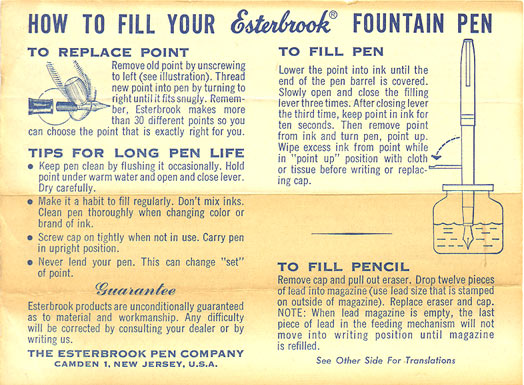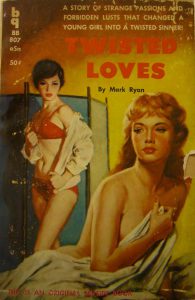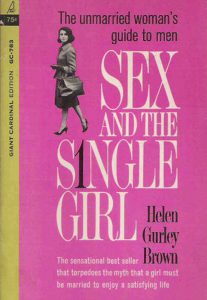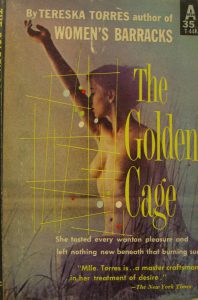 I write with a fountain pen. An Esterbrook plunger model. Not just because it’s eco, or because Patricia Highsmith favored Esterbrooks, or because I’m a luddite contrarian, although all these things are true. I use it because it feels good in my hand and the ink goes from dark to peacock blue as it dries and because every time I have to refill it– Continue reading
I write with a fountain pen. An Esterbrook plunger model. Not just because it’s eco, or because Patricia Highsmith favored Esterbrooks, or because I’m a luddite contrarian, although all these things are true. I use it because it feels good in my hand and the ink goes from dark to peacock blue as it dries and because every time I have to refill it– Continue reading
Dead Lesbians
I was looking forward to Helen Nielsen’s The Fifth Caller (Morrow, 1959) from the Grier-McBride collection–the library catalog lists “Lesbian physicians–Fiction” as the second subject. Alas, only a completionist collector like Barbara Grier would put this rather dull mystery with its few elliptical references to sapphic tendencies in her lesbian library.
The Plot: Dr. Lillian Whitehall has been found dead in her office and all evidence points to her nurse. Nursie can’t defend herself, because she was found unconscious on the beach with her wrists slashed and has no memory of what happened that day. Tall, square-jawed D.A. Investigator (I’m sorry–I’ve already forgotten his name) thinks Nurse Anna is awfully pretty though, Continue reading
Unionizing Lesbians!
Ah the joys of research. Mystery author Sara Gran was once asked at a reading “how much research should a writer do?” Her answer: you can never do enough, basically research until you run out of steam or time. This is the opposite of the usual pragmatic advice that writers should do the bare minimum of research necessary to make their fiction convincing. I was delighted to hear someone else validate what has always been my preferred approach.
For me, writing lesbian pulp parodies is really an excuse to read old Teen magazines, Girl Scout Handbooks, Sears Catalogs, and of course The Ladder, the newsletter of the Daughters of … Read more
Virtual Pulp–A Lesbian Linkorama
I’m not a fan of the internet. I’m an old-fashioned gal who prefers knitting while listening to Alan Farley talk about his Noel Coward obsession on the radio to web surfing. I was violently against ebooks until a royalty statement made me change my tune (turns out I’m making money from them!). Continue reading
Pulp for Dad
 Twisted Loves, by Mark Ryan “an original Bedside Book”
Twisted Loves, by Mark Ryan “an original Bedside Book”
“A story of strange passions and forbidden lusts that changed a young girl into a twisted sinner!”
This is the template for the exploitation pulp. Lots of big breasted, horny women, sex, sex, and more sex, and then a heterosexual rescue on the final pages. From the cover to the content, this is what most people think of when they think of lesbian pulp.
Single Girl Geneaology
 The recent death of Helen Gurley Brown has had me dusting off my copy of Sex and the Single Girl for yet another pleasurable reread. It’s always a happy experience to leaf through my disintegrating paperback, contemplating the advice to drink my “serenity cocktail” on one page (among the many other things HGB anticipated was the jamba juice craze) and wear man-pleasing “slinky black” the next. As good friend and fellow-writer Lynn Peril puts it, “She was so right — and she was so wrong!” Continue reading
The recent death of Helen Gurley Brown has had me dusting off my copy of Sex and the Single Girl for yet another pleasurable reread. It’s always a happy experience to leaf through my disintegrating paperback, contemplating the advice to drink my “serenity cocktail” on one page (among the many other things HGB anticipated was the jamba juice craze) and wear man-pleasing “slinky black” the next. As good friend and fellow-writer Lynn Peril puts it, “She was so right — and she was so wrong!” Continue reading
Flowers for Aaron
I’m always on the look out for traces of past pop culture in contemporary offerings. Perhaps in honor of The Bourne Legacy I should call this DNA or something, but I don’t know enough science to work the term into an apt metaphor. Continue reading
The Real Find
You’ve gone away for the weekend. You’re a tourist, on vacation. You’re wandering around, eating fudge and salt-water taffy, looking at the historic buildings, trying to decide if the shape in the water is a seal or a rock. When you get back to your hotel, you look up the local used bookstore. “Let’s stop by, before we go kayaking,” you might say to your companion. This is why: Continue reading
Inversion on the Beach
 The Golden Cage, Tereska Torrès (1959, Avon, published by arrangement with the Dial Press)
The Golden Cage, Tereska Torrès (1959, Avon, published by arrangement with the Dial Press)
“Miss Torres is a very naughty Aphrodite presiding over a multitude of libidinous extravaganzas.” (Parade of Books)
Some pulps are meant to be skimmed, and the works of Tereska Torrès belong to that category. She favors the Grand Hotel approach to fiction: a group of disparate people are brought together by unusual circumstances and Tereska tells us a series of colorful, unrelated stories about them. She used this technique in Women’s Barracks (1950), the ground-breaking pulp that started the craze for paperback lesbians, and she uses it in The Golden Cage, one result being that you have to search for the lesbian content in the midst of the mostly heterosexual shenanigans. The set-up in Women’s Barracks is that a group of women are brought together when they join the Free French troops during WWII. In the Golden Cage it’s Continue reading
Joe Bonomo’s Wonderful World
I am a fortunate girl. I have friends in high places, who, when they see certain items, divert them from their original path and point them towards me.
 This is what happened the other night when I was presented with the works of Joe Bonomo. I caught my breath Continue reading
This is what happened the other night when I was presented with the works of Joe Bonomo. I caught my breath Continue reading


